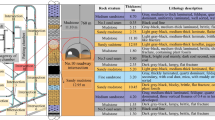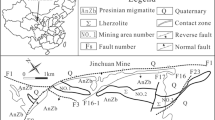Abstract
Large deformations often occur during and after the construction of deep roadways, particularly in fractured hard rock. With persistent deformation, there may be mechanistically unexplained, repeated failure phenomena—they are difficult problems to analyse and address. One strategy is to analyse the failure characteristics of roadways and internal cracking characteristics of the surrounding rock which can be analysed with a digital borehole televiewer and three-dimensional laser scanning equipment. Here, we used this approach combined with research on geostress, joint information, and mechanical properties of rock to reveal the preliminary large deformation mechanism of deep fractured roadways. Based on a cracking-restraint method for engineering design, a control technique is proposed to prevent and control large deformations. The depth and degree of cracking are considered to design parameters and determine the appropriate installation time of the support system. To test this approach, the proposed control technique was applied to a roadway project more than 700 meters deep. The monitoring results demonstrated that this control strategy effectively restrained the cracking of surrounding rocks, improved the quality index of the rock mass, and reduced surface displacement. In addition, due to the improved deformation capacity of the bolt structure, an anti-deformation and energy-absorbing bolt can bear large deformations, preventing premature bolt failures in mining environments.




























Similar content being viewed by others
References
Aydan Ö, Akagi T, Kawamoto T (1993) The squeezing potential of rocks around tunnels; theory and prediction. Rock Mech Rock Eng 26:137–163
Barla G (1995) Squeezing rocks in tunnels. ISRM News J:44–49
Barla G, Bonini M, Semeraro M (2011) Analysis of the behaviour of a yield-control support system in squeezing rock. Tunn Undergr Sp Technol 26:146–154
Barton N, Lien R, Lunde J (1974) Engineering classification of rock masses for the design of tunnel supports. Rock Mech 6:189–239
Bieniawski ZT (1989) Engineering rock mass classifications. Wiley, New York
Cai MF, Peng H (2011) Advance of in-situ stress measurement in china. Rock Mech Geotech Eng 3:373–384
Cai MF, Qiao L, Li C, Yu B, Wang S (2000) Results of in situ stress measurements and their application to mining design at five Chinese metal mines. Int J Rock Mech Min Sci 37:509–515
Cao RH, Cao P, Lin H (2017) A kind of control technology for squeezing failure in deep roadways: a case study. Geom Nat Haz Risk 8:1715–1729
Carranza-Torres C, Fairhurst C (2000) Application of the Convergence-Confinement method of tunnel design to rock masses that satisfy the Hoek-Brown failure criterion. Tunn Undergr Sp Technol 15:187–213
Dwivedi RD, Singh M, Viladkar MN, Goel RK (2013) Prediction of tunnel deformation in squeezing grounds. Eng Geol 161:55–64
Feng XT, Hudson J (2011) Rock engineering design. CRC Press Taylor & Francis, Boca Raton
Feng XT, Hao XJ, Jiang Q, Li SJ, Hudson JA (2016) Rock cracking indices for improved tunnel support design: a case study for columnar jointed rock masses. Rock Mech Rock Eng 49:2115–2130
Guo HS, Feng XT, Li SJ, Yang CX, Yao ZB (2017) Evaluation of the integrity of deep rock masses using results of digital borehole televiewers. Rock Mech Rock Eng 50:1371–1382
He MC (2014) Latest progress of soft rock mechanics and engineering in China. Rock Mech Geotech Eng 6:165–179
He BG, Li H, Zhang XW, Xie JH (2020) A novel analytical method incorporating valve pressure for the controlled drainage of transport tunnels. Tunn Undergr Sp Technol 106:103637. https://doi.org/10.1016/j.tust.2020.103637
Jiang Q, Feng XT, Li SJ, SU GS, Xiao YX, (2019) Cracking-restraint design method for large underground caverns with hard rock under high geostress condition and its practical application. Chin J Rock Mech Eng 38(6):1081–1101 (in Chinese)
Jiang Q, Zhong S, Pan PZ, Shi YE, Kou YY (2020) Observe the temporal evolution of deep tunnel’s 3d deformation by 3D laser scanning in the Jinchuan No. 2 mine. Tunn Undergr Sp Technol 97:103237
Kalman K (2003a) History of the sprayed shotcrete lining method—part I: milestones up to the 1960s. Tunn Undergr Sp Technol 18:57–69
Kalman K (2003b) History of the sprayed shotcrete lining method–part II: milestones up to the 1960s. Tunn Undergr Sp Technol 18:71–83
Li CC (2017) Principles of rockbolting design. Rock Mech Geotech Eng 9:396–414
Li SJ, Feng XT, Wang CY, Hudson JA (2013) ISRM suggested method for rock fractures observations using a borehole digital optical televiewer. Rock Mech Rock Eng 46:635–644
Li CC, Kristjansson G, Høien AH (2016) Critical embedment length and bond strength of fully encapsulated rebar rockbolts. Tunn Undergr Sp Technol 59:16–23
Ortlepp WD (2001) The behaviour of tunnels at great depth under large static and dynamic pressures. Tunn Undergr Sp Technol 16:41–48
Panda MK, Mohanty S, Pingua BMP, Mishra AK (2014) Engineering geological and geotechnical investigations along the head race tunnel in Teesta Stage-III hydroelectric project, India. Eng Geol 181:297–308
Rocscience (2002) Rocscience dips user’s guide. Rocscience Inc, Toronto
Salimian MH, Baghbanan A, Hashemolhosseini H, Dehghanipoodeh M, Norouzi S (2017) Effect of grouting on shear behavior of rock joint. Int J Rock Mech Min Sci 98:159–166
Singh B, Viladkar MN, Samadhiya NK (1995) A semi-empirical method for the design of support systems in underground openings. Tunn Undergr Sp Technol 10:375–383
Tan XJ, Chen WZ, Liu HY, Chan AHC, Tian HM, Meng XJ, Wang FQ, Deng XL (2017) A combined supporting system based on foamed concrete and U–shaped steel for underground coal mine roadways undergoing large deformations. Tunn Undergr Sp Technol 68:196–210
Tian YC, Liu QS, Ma H, Liu Q, Deng PH (2018) New peak shear strength model for cement filled rock joints. Eng Geol 233:269–280
Xu S, Hou PY, Cai M, Li YH (2019) An experiment study on a novel self-swelling anchorage bolt. Rock Mech Rock Eng 52:4855–4862
Yang ZQ (2017) Key technology research on the efficient exploitation and comprehensive utilization of resources in the deep Jinchuan Nickel deposit. Eng 4:559–566
Yang SQ, Chen M, Jing HW, Chen KF, Meng B (2017) A case study on large deformation failure mechanism of deep soft rock roadway in Xin’An coal mine, China. Eng Geol 217:89–101
Yu WJ, Wang WJ, Chen XY, Du SH (2015) Field investigations of high stress soft surrounding rocks and deformation control. Rock Mech Geotech Eng 7:421–433
Zhou H, Zhang CQ, Li Z, Hu DW, Hou J (2014) Analysis of mechanical behavior of soft rocks and stability control in deep tunnels. Rock Mech Geotech Eng 6:219–226
Zhou YY, Xu DP, Gu GK, Liu K, Wan LP, Wang TL, Yang JB (2019) The failure mechanism and construction practice of large underground caverns in steeply dipping layered rock masses. Eng Geol 250:45–64
Acknowledgements
The authors gratefully acknowledge the financial support from the National Natural Science Foundation of China (no. 51621006) and National Key Research and Development Program of China (no. 2016YFC0600707). For their help, we also thank Professor Cheng-Xiang Yang, Associate Professor Shuai Xu, Mr. Zhi-Bin Yao, Dr. Xiao-Jun Yu, Dr. Feng Lin, and Ms. Xin-Yue Wang from the Northeastern University, Dr. Lei-bo Song and Dr. Jie Liu from the Shaoxing University, and Dr. Guo-Qiang Zhu and Mr. Shan Zhong from the Institute of Rock and Soil Mechanics, Chinese Academy of Sciences. Thanks to Xiao-ying Du for her help in language editing. Finally, we are grateful to the editors and reviewers.
Author information
Authors and Affiliations
Corresponding author
Ethics declarations
Conflict of Interest
The authors declare that they have no conflicts of interest.
Additional information
Publisher's Note
Springer Nature remains neutral with regard to jurisdictional claims in published maps and institutional affiliations.
Rights and permissions
About this article
Cite this article
Zhao, YM., Feng, XT., Jiang, Q. et al. Large Deformation Control of Deep Roadways in Fractured Hard Rock Based on Cracking-Restraint Method. Rock Mech Rock Eng 54, 2559–2580 (2021). https://doi.org/10.1007/s00603-021-02384-4
Received:
Accepted:
Published:
Issue Date:
DOI: https://doi.org/10.1007/s00603-021-02384-4




